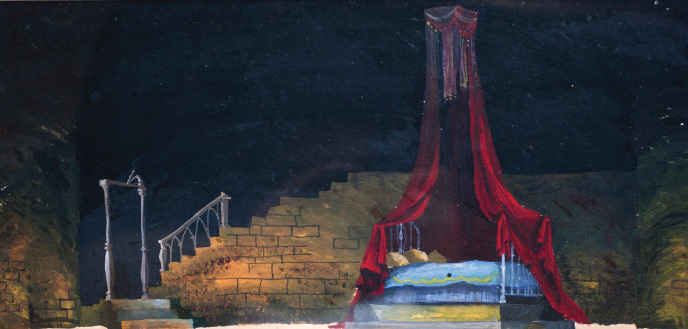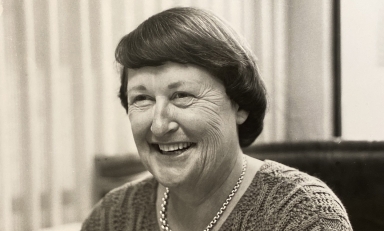
Ming Cho Lee '53 didn't turn into the "dean of American set designers" overnight. But as biographer Arnold Aronson explains, it was Omar Paxson '48 who turned Lee into a designer
Ming Cho Lee '53 arrived on the Occidental campus on Oct. 3, 1949, on his 19th birthday. The transition to America was not easy; Lee was one of just three Chinese students on a campus of 1,466. In his first class at Oxy—a History of Civilization lecture—"I didn't understand one word," Lee told biographer Arnold Aronson. "I didn't expect the U.S. to feel like a foreign country. I was very much by myself. But for some reason I said, 'I belong here.'"
He found solace (and better grades) by taking studio art classes for nine hours a week, and with the help of assistant art professor Dick Swift, broadened his social circles as well. But his painterly style didn't suit him for the Abstract Expressionism so prevalent in American art of the time, and (after a summer flirtation with a career in film) Lee switched his major from art to speech, where he found a mentor in speech and drama instructor Omar Paxson '48. Paxson put him to work immediately designing the decor for The Silver Whistle, about a group of elderly people in a nursing home, and the rest is theatrical history.
Lee's journey from foreign student to "the dean of American set designers," as New York Times critic Mel Gussow called him, is lavishly documented in Ming Cho Lee: A Life in Design (Theatre Communications Group; $75). At 336 pages and with more than 500 illustrations, the resulting book is a long-gestating passion project for Aronson, a professor of theater at Columbia University, who first interviewed Lee for his 1985 book American Set Design.
Of that volume's 10 other subjects, eight had been former students or assistants of Lee, a 2003 National Medal of Arts honoree who designed more than 30 productions for Joseph Papp's Public Theater and has taught at the Yale School of Drama since 1969. "It was clear to me then that Ming deserved a book of his own," Aronson writes. "It has obviously taken me a while to achieve that goal, but if there is a silver lining to the delay, it is that I am now able to encompass an entire career."
Occidental: Some 25 years passed between the publication of American Set Design and the beginnings of this book. What finally brought you back to doing a full book on Ming?
Aronson: From the time I did American Set Design I felt Ming deserved a book of his own. I began to think seriously about it around 2000, but various things intervened.
What was the most surprising thing you learned about Ming in 100 hours of conversations?
Mostly it was learning about his early life, from growing up in China to his first years in New York. I had known almost nothing about his childhood.
What do you consider to be his most significant legacy to the theater?
There are two things in particular. First, he transformed American design in the 1960s and 1970s, and in many ways the theater still reflects his aesthetics. His importance as an innovator will always remain, and he will be a significant historical figure, even as his style of design passes out of favor.
But the more long-lasting impact will be his teaching. No designer of his prominence has taught as many students, and as many generations of students, as Ming has. He instilled in his students a rigor, a belief in the text (whether drama or opera), and a careful analytical approach. But he always coupled his aesthetics with the notion of art as a tool for social and political change—a belief that art can change the world for the better.
His students at Yale included not only set designers but students from all design disciplines, as well as directors, writers, and even art and architecture students. So his influence extends to the entire art of theater and perhaps beyond. Given the number of his students working in the theater today as well as teaching, it is difficult to go to theater, opera, or dance without experiencing at least an echo of Ming's work.
Were you at all surprised by the influence of his Oxy education on his becoming a designer?
Yes! I knew he had attended Oxy, but until I began interviewing him I never realized the extent of its influence. He was a skilled painter when he arrived in the United States, but while he had seen opera and theater, he had never worked in it in any capacity. Omar Paxson turned him into a designer. His work at Oxy would do any designer proud—but these were his first efforts! Omar also made him an actor! Ming also paid great tribute to his art teachers as well.
What were your impressions of Omar?
Omar was warm and generous. He and his wife, Helen, welcomed me (and on a second visit, my wife) into his home and showed me the designs that they had wisely saved. And he was full of stories of Ming and other alumni. Having met him, I can understand how Ming felt so comfortable with him and was willing to try anything. I feel very privileged to have had the opportunity to meet him. (Helen, by the way, came out to New York for the book party a few weeks ago.)
Where did your own interest in theater originate?
I was attracted to theater early on—who knows why? After college I worked for a few years as a professional stage manager, then went back to grad school for a Ph.D. in theater. Most relevant to this project, I became editor of Theatre Design & Technology, the journal of the U.S. Institute for Theatre Technology. Ed Kook, one of the founders of the organization (and Jo Mielziner's lighting person, and the person who connected Ming with Mielziner), suggested I write about American designers since he felt they were being overshadowed by Europeans. It was the articles I wrote for the journal that led to American Set Design.
What was Ming's reaction to the book?
I think he was very pleased. Ming can be very self-deprecating, and he worried about how people would respond to the book, but he seemed happy. And while he would never say it, many people I have spoken to feel that he richly deserved such a book.
Having completed the definite examination of Ming's work, are there any questions you still have for him?
Every once in a while Ming comes out with an anecdote I never heard, or remembers something that clarifies something in the book, so I am sure there are many things still to be found—but for now, no more questions.



